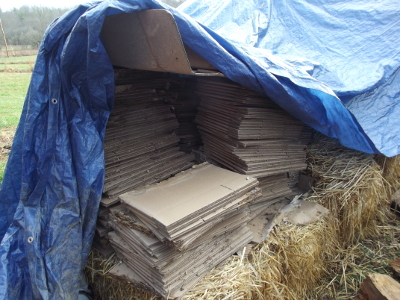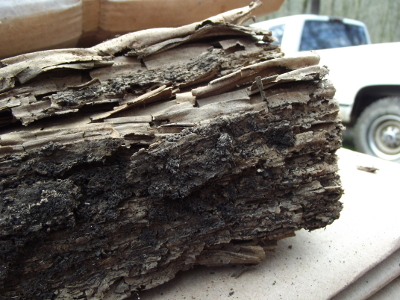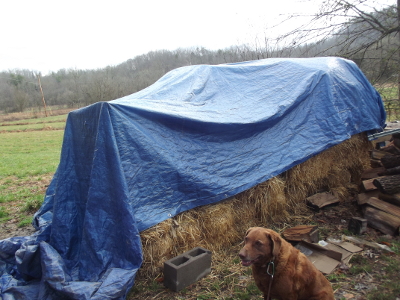
Cardboard lessons
 I
hardly know where to start telling you the story of the cardboard
motherlode. Mark was the one who found it, even though we were
both in the same room. My husband has developed quite a knack for
ferreting out biomass going to waste, so when our friends told us that
they were bringing a lot of cardboard boxes to the recycling center,
Mark's ears perked right up.
I
hardly know where to start telling you the story of the cardboard
motherlode. Mark was the one who found it, even though we were
both in the same room. My husband has developed quite a knack for
ferreting out biomass going to waste, so when our friends told us that
they were bringing a lot of cardboard boxes to the recycling center,
Mark's ears perked right up.
The story is a
bittersweet one of composting
old dreams, and made
me feel very lucky that we'd started our microbusiness and writing
ventures in the era
of the internet. The owner of the unwanted boxes is a writer who
had gone the semi-traditional self-publishing route decades ago.
He ordered thousands of copies of his books, enough to make it
worthwhile to get them printed, then a big truckload of cardboard boxes
to use when mailing the texts to customers.
 At that time, it wasn't
really possible to follow my microbusiness admonition to keep your
startup costs below $1,000 and not to fill your barn with inventory,
nor could our friend easily sell his books to a worldwide market at no
cost (except a per-book fee) on Amazon. I suspect he also didn't
really need the cash, and liked writing more than he liked marketing
his works --- having to go get a job in Kingsport if our
microbusinesses fail is a strong incentive to keep our noses to the
grindstone.
At that time, it wasn't
really possible to follow my microbusiness admonition to keep your
startup costs below $1,000 and not to fill your barn with inventory,
nor could our friend easily sell his books to a worldwide market at no
cost (except a per-book fee) on Amazon. I suspect he also didn't
really need the cash, and liked writing more than he liked marketing
his works --- having to go get a job in Kingsport if our
microbusinesses fail is a strong incentive to keep our noses to the
grindstone.
So the books sat in our
friend's office and the boxes moldered in his barn until Mark heard
about their planned journey to the recycler. The books were
already gone, but three huge bales of cardboard boxes were free for the
taking. They'd been sitting on the ground for years and some had
lost as much as half their mass into the soil, but most were perfect
kill mulch material.
 Some of the partially
degraded boxes had mycelium growing on them, which just supports my
hypothesis that corrugated cardboard is like candy for soil
microorganisms. I've been wondering lately whether Steve Solomon
is right to say that the glue is what makes cardboard so enticing, or
whether the answer is much simpler. Could the corrugations give
just the right amount of air space to keep the cardboard moist but
still well aerated, creating the perfect environment for fungal growth?
Some of the partially
degraded boxes had mycelium growing on them, which just supports my
hypothesis that corrugated cardboard is like candy for soil
microorganisms. I've been wondering lately whether Steve Solomon
is right to say that the glue is what makes cardboard so enticing, or
whether the answer is much simpler. Could the corrugations give
just the right amount of air space to keep the cardboard moist but
still well aerated, creating the perfect environment for fungal growth?
We've stockpiled the
cardboard with the straw at our parking area and I carry in a big
duffel bag full each time I walk Lucy. I'd like to say the
cardboard will feed my garden forever, but I figure it might last...two
weeks?
Want more in-depth information? Browse through our books.
Or explore more posts by date or by subject.
About us: Anna Hess and Mark Hamilton spent over a decade living self-sufficiently in the mountains of Virginia before moving north to start over from scratch in the foothills of Ohio. They've experimented with permaculture, no-till gardening, trailersteading, home-based microbusinesses and much more, writing about their adventures in both blogs and books.
Want to be notified when new comments are posted on this page? Click on the RSS button after you add a comment to subscribe to the comment feed, or simply check the box beside "email replies to me" while writing your comment.

Cardboard is usually made with a starch-based glue. I guess molds and critters like their carbohydrates.
I read about kill mulching form you all the time, but lately I've had an unanswered question. I used kill mulching around some tomato starts a couple of years back and found that it retained way too much moisture and contributed to the plants stunting. I live in the Pacific Northwest, so there's lots of rain over here, and I was wondering if there's such a thing as mulching too early? Should I be waiting for a specific soil temperature or weather before I go covering up the ground? And yes, I left breathing room around the base of the plants, but maybe what I thought was enough breathing room isn't? Do you have problems with weeds around the bases of plants? And do you have any recommendations on how to find free cardboard when you don't really have friends (therefore lucky caches aren't available).
Wow, lots of questions, sorry! Just want to succeed so badly this year!
Roland --- Fungi do really enjoy carbs. That's why people often grow mushroom spawn on grain at first. So maybe Solomon is right and it's all about the glue. (Or at least partly about the glue.)
Brandy --- Good question! Are you sure that excess water is what was causing your problem? Our climate is very wet too and mulch doesn't cause a problem here. Water tends to drain down through the soil (unless you have a waterlogging problem) faster than it evaporates off the top (unless you live in a very sunny place like the southwest). (Lots of unlesses there, but you probably get the point.)
When I was working the kinks out of my mulching campaign, I did find that high carbon mulches will stunt plants since soil microorganisms grab nitrogen out of the soil to counteract the carbon. What are you making your kill mulches with? Wood chips and even tree leaves are too woody for the vegetable garden, even if they've been composting for quite a while. Paper and non-corrugated cardboard have also caused stunting for me. Mulches safe to put around vegetables include corrugated cardboard, straw, and grass clippings. If you put a bit of compost underneath, you can get away with using woodier mulches.
But here's another thought. Are you positive the mulch was even responsible at all? The most common cause of stunted tomatoes is cold. They're very sensitive to temperatures below 50 degrees, and if a tomato plant gets set back by cold weather, it could spend months looking puny.
To answer your specific question, though, I don't worry about mulching early (although I do pull back the mulch in the spring to preheat the soil if I'm going to plant a spring crop from seed.) When using vegetable garden type mulches, I mulch right up to the base of the plant because I hate trying to pick weeds through straw.
You'll have much better luck finding free cardboard if you live in a city. Refrigerator stores are supposed to be perfect for big boxes, and someone else recommended liquor stores. Even our local dollar store and grocery store will give us cardboard, but their boxes are smaller, which makes them less fun to kill mulch with.
Wow, great reply Anna! Thank you!
From what I researched about the stunting and root rot, and the wet state of the soil, I assumed it was compounded by the mulch. Although it was a raised bed, the yard I have is clay soil covered by only an inch of topsoil, so maybe seven inches of organic matter wasn't enough for the seedling? It wasn't temperature, I planted later with larger seedlings on purpose, I knew I wasn't experienced enough with tomatoes to risk cutting it closer to frost dates. However, I mulched with straw over newspaper, so perhaps your own experience with paper mulch may also be partly to blame? All I know is that I was sad to see the seedlings never grow an inch. Oh they put out tons of flowers and managed some tiny, tiny Roma tomatoes... They tried, bless their hearts, but never got larger than a foot tall.
In that case, I'd guess the newspaper might have been the problem. Lots of books recommend using it in kill mulches, and I will around woody plants, in a kill mulch I won't plant into for a few months, or with a lot of compost. But I feel like it's too high in carbon for an active vegetable garden.
Clay can be tough to deal with, though. It's possible that your issue could be water-related with the clay, in which case I recommend building upward as organic matter supplies allow.
Good luck!